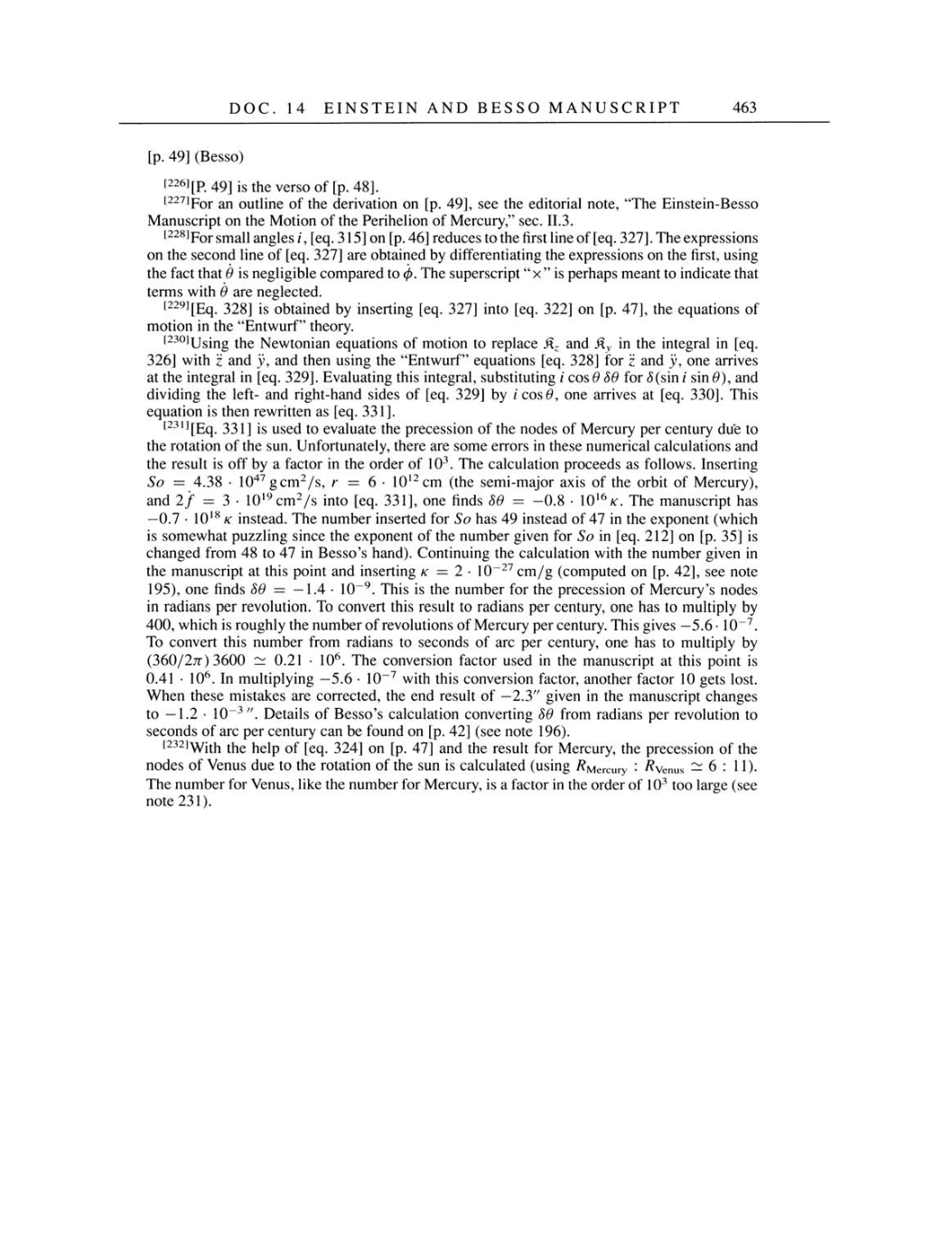DOC. 14
EINSTEIN AND
BESSO
MANUSCRIPT
463
[p. 49]
(Besso)
[226][P.
49] is
the
verso
of
[p.
48].
[227]For
an
outline of the derivation
on [p.
49],
see
the editorial
note,
"The Einstein-Besso
Manuscript
on
the Motion of the Perihelion of
Mercury," sec.
II.3.
[228]For small
angles
i,
[eq.
315]
on [p.
46]
reduces
to the first line
of
[eq. 327].
The
expressions
on
the second line of
[eq.
327]
are
obtained
by
differentiating
the
expressions on
the
first, using
the fact that
0
is negligible compared to 0.
The
superscript
"x"
is
perhaps meant
to
indicate that
terms
with 0
are
neglected.
[229][Eq.
328]
is
obtained
by
inserting
[eq.
327]
into
[eq.
322] on
[p.
47],
the
equations
of
motion
in the
"Entwurf"
theory.
[230]Using
the Newtonian
equations
of motion
to replace
&z
and
&y
in the
integral
in
[eq.
326]
with
z
and
y,
and
then
using
the "Entwurf"
equations
[eq.
328]
for
z
and
y, one
arrives
at
the
integral
in
[eq.
329]. Evaluating
this
integral, substituting
i
cos 0
80
for
5(sin
i
sin 0), and
dividing
the left- and
right-hand
sides
of
[eq.
329]
by i
cos
0,
one
arrives
at
[eq.
330].
This
equation
is
then rewritten
as [eq.
331].
[231][Eq.
331]
is
used
to
evaluate the
precession
of the nodes of
Mercury per century
due
to
the rotation of
the
sun.
Unfortunately,
there
are some errors
in
these numerical calculations
and
the result
is
off
by a
factor in the order of
103.
The calculation
proceeds as
follows.
Inserting
S0
=
4.38
•
1047
gcm2/s,
r
=
6
•
1012cm
(the
semi-major
axis of the orbit of
Mercury),
and
2f
=
3
•
1019cm2/s
into
[eq.
331],
one
finds 80
=
-0.8
•
1016K.
The
manuscript
has
-0.7
•
1018k
instead. The number inserted for
S0
has 49 instead of
47 in
the
exponent
(which
is
somewhat
puzzling
since the
exponent
of the number
given
for S0
in
[eq.
212] on
[p. 35]
is
changed
from 48
to 47 in
Besso's
hand).
Continuing
the
calculation
with the
number
given
in
the
manuscript
at
this
point
and
inserting
k
=
2
•
10-27
cm/g
(computed
on [p.
42],
see
note
195), one
finds 80
=
-1.4
•
10-9. This
is
the number for the
precession
of
Mercury's
nodes
in
radians
per
revolution.
To convert this
result
to
radians
per century, one
has
to
multiply
by
400,
which
is roughly
the number of revolutions of
Mercury per
century.
This
gives
-5.6
•
10-7.
To
convert
this number from radians
to
seconds of
arc
per century,
one
has
to multiply
by
(360/27T)
3600
=
0.21
•
106.
The conversion factor used
in the
manuscript
at this
point
is
0.41
•
106.
In
multiplying
-5.6
•
10-7
with this
conversion
factor,
another factor
10 gets
lost.
When these mistakes
are
corrected, the
end result of
-2.3"
given
in the
manuscript changes
to
-1.2
•
10-3".
Details of Besso's calculation
converting
80 from
radians
per
revolution
to
seconds of
arc per century can
be
found
on [p. 42] (see
note
196).
[232]With
the
help
of
[eq.
324]
on [p.
47]
and
the result for
Mercury,
the
precession
of the
nodes of
Venus
due
to
the rotation of
the
sun
is
calculated
(using
RMercury
:
RVenus
-
6
:
11).
The number for
Venus,
like
the number for
Mercury,
is
a
factor
in the order of
103 too large (see
note 231).
